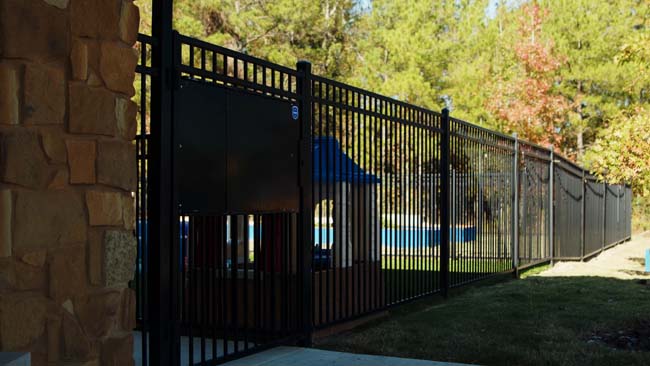Iron Fence: A Durable and Stylish Choice for Your Home
Elevate your Houston home security without compromising style with iron fencing, a perfect blend of strength and elegance. In the realm of fences, there’s one material that consistently stands the test of time—Iron. Known for its durability and classic appeal, iron fencing not only ensures optimal safety but also adds a significant touch of sophistication to any residential landscape. Dive into our blog post as we explore why iron fences continue to be popular among homeowners in Houston and beyond; their timeless beauty and unmatched durability are just scratching the surface!

What is an Iron Fence?
An iron fence is a type of fencing made from sturdy and durable iron materials. It is known for its strength, resilience, and classic appearance, making it a popular choice for homeowners who prioritize both security and aesthetics. Iron fences consist of vertical pickets or bars that are connected by horizontal rails, forming a solid barrier around the property.
One of the defining characteristics of an iron fence is its longevity. Unlike other fencing materials like wood or vinyl that may deteriorate over time, iron fences are built to withstand various weather conditions and can last for decades with minimal maintenance. This makes them a smart long-term investment for homeowners who desire a sturdy and reliable fencing option.
Imagine living in a neighborhood with frequent storms and strong winds. An iron fence would provide the necessary protection against such elements, ensuring the safety and security of your property. Additionally, its durability helps deter intruders, providing an extra layer of security for your home.
Another significant aspect of iron fences is their timeless appeal. The elegant and sophisticated designs available seamlessly blend with various architectural styles, whether it’s a traditional Victorian home or a modern contemporary dwelling. With options ranging from ornate and intricate patterns to more minimalistic designs, homeowners can find an iron fence that complements their unique style preferences.
Types of Iron Fences
Iron fences come in various styles and designs to suit different needs and preferences. Here are three common types:
- Wrought Iron Fence:
- Wrought iron fences are renowned for their artistic craftsmanship and intricate details.
- These fences are created by bending and shaping individual bars into decorative patterns.
- They offer both security and visual appeal to enhance the overall aesthetics of the property.
- Aluminum Fence with Iron Accents:
- This type of fence combines the benefits of both aluminum and iron materials.
- The main body of the fence is made from lightweight and low-maintenance aluminum, while the accents or ornamental parts are crafted from iron.
- It provides a balance between durability, affordability, and aesthetics.
- Iron Panel Fence:
- Iron panel fences consist of pre-made panels that are attached to posts.
- These panels can come in various designs, from simple and sleek to more elaborate patterns.
- They offer ease of installation and provide a versatile option for homeowners seeking a classic iron fence look.
Understanding the different types of iron fences allows homeowners to choose one that aligns with their specific needs and preferences, whether it’s for security, aesthetics, or a combination of both.
Benefits of Iron Fencing
Iron fencing offers a plethora of benefits that make it a popular choice for homeowners seeking durability and style. Let’s explore some of the key advantages:
Durability and Security
When it comes to longevity, iron fencing stands out as an exceptional option. Made from sturdy and robust materials, such as wrought iron or galvanized steel, it can withstand harsh weather conditions and resist damage from external elements over time. This remarkable durability ensures that your fence will remain in excellent condition for years to come, providing long-lasting protection for your property.
In terms of security, iron fencing is highly effective at deterring intruders and enhancing the safety of your home. Its formidable construction creates a strong physical barrier that is difficult to breach. Unlike other types of fencing materials, iron fences are not easily climbed or cut through, making them an excellent choice for those prioritizing security and peace of mind.
Additionally, the visibility provided by the ornamental design of iron fences allows homeowners to maintain a clear view of their surroundings. This enables you to observe any potential threats approaching your property, enhancing security measures further.
Iron fencing can also be customized to meet specific security needs. Homeowners can add additional features like spear-topped pickets or decorative finials to increase the deterrent effect and make climbing or trespassing even more challenging.
The durability and security offered by iron fencing have made it a popular choice for homeowners in various settings. Whether you live in a suburban neighborhood or a rural area, having a strong and secure fence can instill a sense of safety and protect your property from unauthorized entry.
For instance, imagine living in a bustling neighborhood where petty thefts are common. By installing an iron fence around your home, you create an effective deterrent against potential intruders.
Now that we’ve explored the durability and security aspects of iron fencing, let’s move on to the next section, where we’ll discuss its design flexibility and aesthetic appeal.
Design Flexibility
Iron fencing offers a remarkable level of design flexibility, making it an ideal choice for homeowners who want to enhance both the aesthetics and functionality of their property. With iron fences, you have the freedom to customize and personalize your fence design according to your preferences and specific needs. Whether you’re aiming for a classic or modern look, iron fencing can easily be adapted to suit various architectural styles.
One of the key advantages of iron fences is the wide range of ornamental elements that can be incorporated into the design. From intricate scrollwork and decorative finials to unique patterns and motifs, the options are virtually endless. These embellishments not only add visual interest but also reflect your personal style and make a statement about your home.
For instance, if you have a Victorian-style residence, you might consider an iron fence with elaborate filigree details and carefully crafted floral patterns. On the other hand, if your home has a more contemporary design, sleek lines and minimalistic elements can be incorporated into the iron fencing to create a stylish and sophisticated look.
Furthermore, when it comes to color choices, iron fences provide versatility as well. While traditional black is a popular option that exudes timeless elegance, iron fences can also be painted in other colors to complement your existing exterior palette or match the overall theme of your property. Whether you prefer a bold statement or a subtle blend with your surroundings, customization is possible with iron fencing.
Installation Process for Iron Fences
The installation process for iron fences typically involves several key steps to ensure a durable and secure structure. Proper preparation and execution during installation are vital for achieving long-lasting results that will withstand the test of time.
To begin, it’s important to mark out the fence line and determine the exact placement of each post. This ensures accuracy in measuring and positioning, which is crucial for maintaining the integrity of the fence line.
Next, the holes for the fence posts are dug. These holes should be deep enough to provide a stable foundation and prevent the fence from leaning or shifting over time. The depth of the holes may vary depending on factors such as soil conditions and local building codes.
Once the holes are dug, the posts are set in place using a combination of concrete and gravel. This helps to secure the posts vertically and adds stability to the overall structure. It’s essential to allow sufficient time for the concrete to cure properly before proceeding with further installation steps.
After the posts have been securely set, horizontal rails are attached to connect the posts and provide support for the iron panels or pickets. These rails are typically fastened with brackets or screws, ensuring a secure and rigid framework for your iron fence.
Finally, the iron panels or pickets are installed between the rails. These can be welded or attached using specialized brackets, depending on your specific design preferences and requirements. The installation of gates and other additional features, such as decorative elements or security mechanisms, follows a similar process.
By following these meticulous steps during installation, you can ensure that your iron fence is not only visually appealing but also structurally sound and durable.
Materials Needed for Installation
When it comes to installing iron fencing, there are several essential materials you will need to ensure a successful and durable installation. Let’s take a closer look at these materials and their importance in creating a stunning and secure iron fence for your home.
First and foremost, you will need the main component of the iron fence itself: the iron panels. These panels typically come in various sizes and designs, allowing you to choose one that complements the style of your home. The quality of these panels is crucial as they form the foundation of your fence’s strength and durability.
To connect and secure the iron panels together, you will require brackets or fence brackets. These brackets are responsible for holding the panels firmly in place, ensuring that they can withstand external forces such as wind or pressure without compromising their stability.
Imagine living in an area with strong winds or frequent storms. Your iron fence needs to be securely installed using high-quality brackets to prevent it from toppling over during extreme weather conditions.
In addition to brackets, you will also need screws or bolts for attaching the panels to the brackets securely. These screws should be resistant to corrosion since iron fencing is typically exposed to outdoor elements, such as rain and humidity.
Another essential material required for iron fence installation is concrete. Concrete plays a vital role in providing stability and support to the fence posts. Properly anchoring the posts into concrete ensures that your fence remains upright and sturdy over time.
Lastly, don’t forget about gate hardware, which includes hinges, latches, and locks if you plan on having a gate as part of your iron fence. These components are essential for both functionality and security purposes, allowing you easy access while maintaining privacy and protection.
It’s important not to overlook the significance of using high-quality materials during the installation process. By investing in durable iron panels, sturdy brackets, corrosion-resistant screws, reliable concrete, and dependable gate hardware, you can ensure that your iron fence stands the test of time and provides both aesthetics and security for your home.
Cost Factors in Iron Fencing
When considering installing an iron fence for your home, it’s crucial to be aware of the various cost factors involved. Understanding these factors can help you make informed decisions about your budget and choose the best option that meets your needs. Let’s explore some of the key cost factors associated with iron fencing.
The size and length of the fence will significantly impact the overall cost. A larger fence will naturally require more materials, driving up the expenses. Additionally, longer fences may require additional labor costs due to increased installation time.
For instance, if you have a large property with extensive perimeter fencing needs, you will likely incur higher costs compared to someone who only needs a small section of iron fencing for their garden.
Another significant factor influencing the cost is the design and style of the iron fence. More intricate designs or custom patterns may require specialized fabrication and craftsmanship, which can increase both material and labor expenses.
Additionally, accessories such as decorative finials or post caps can enhance the appearance of your iron fence but may add extra costs to your project. It’s important to consider these accessories’ value in achieving the desired aesthetic appeal while keeping within your budget limitations.
Moreover, installation costs are a crucial aspect to take into account. Hiring professionals for proper installation ensures a high-quality and secure fence but may come at an additional cost compared to a DIY approach. Obtaining quotes from multiple contractors and comparing their prices can help you find a reasonable balance between quality and affordability.
It’s worth noting that the maintenance required for iron fencing should also be factored into the overall cost. While iron fences are generally durable, they may require periodic painting or anti-rust treatments to maintain their appearance and longevity.
By considering these various cost factors, you can make an informed decision about your investment in an iron fence while balancing your budget and desired aesthetic outcome.








